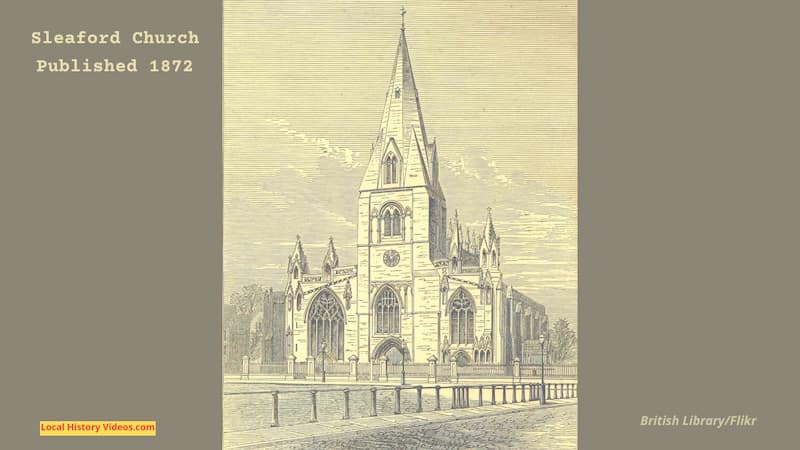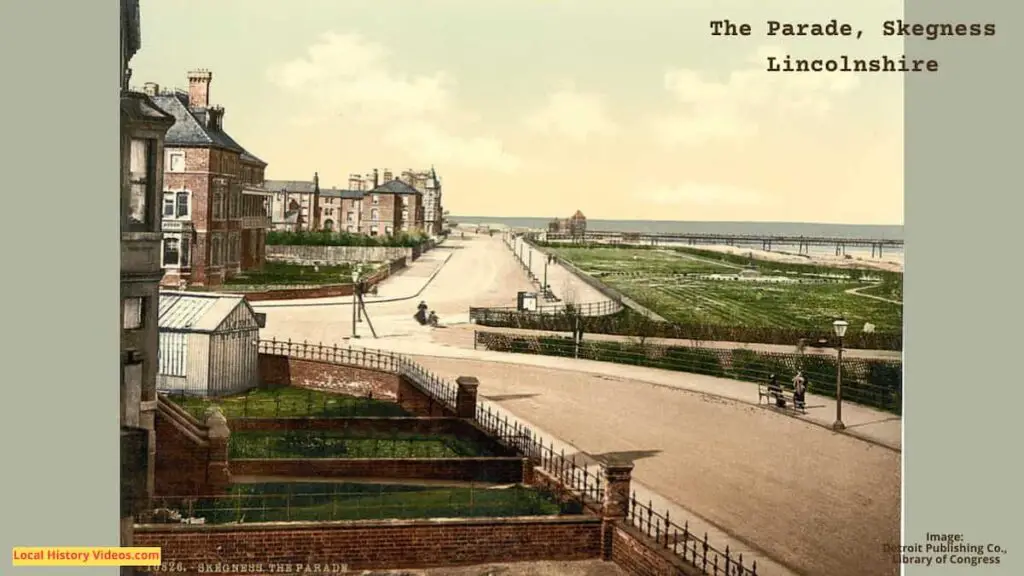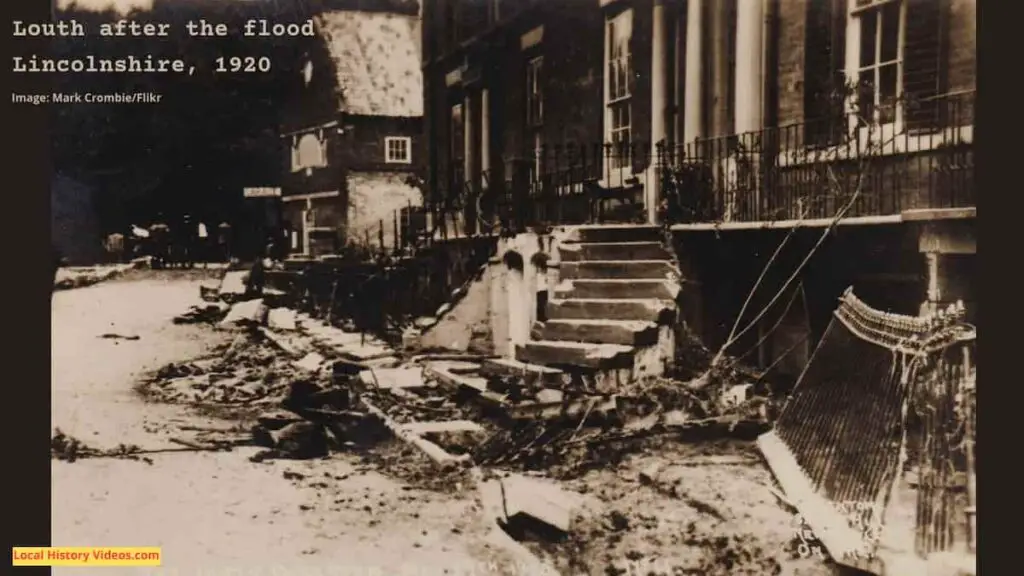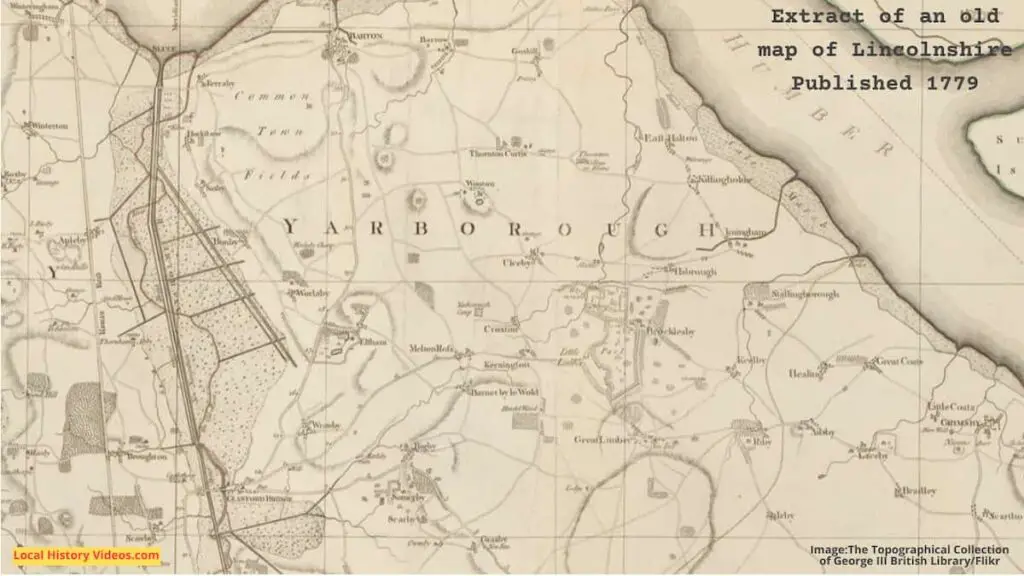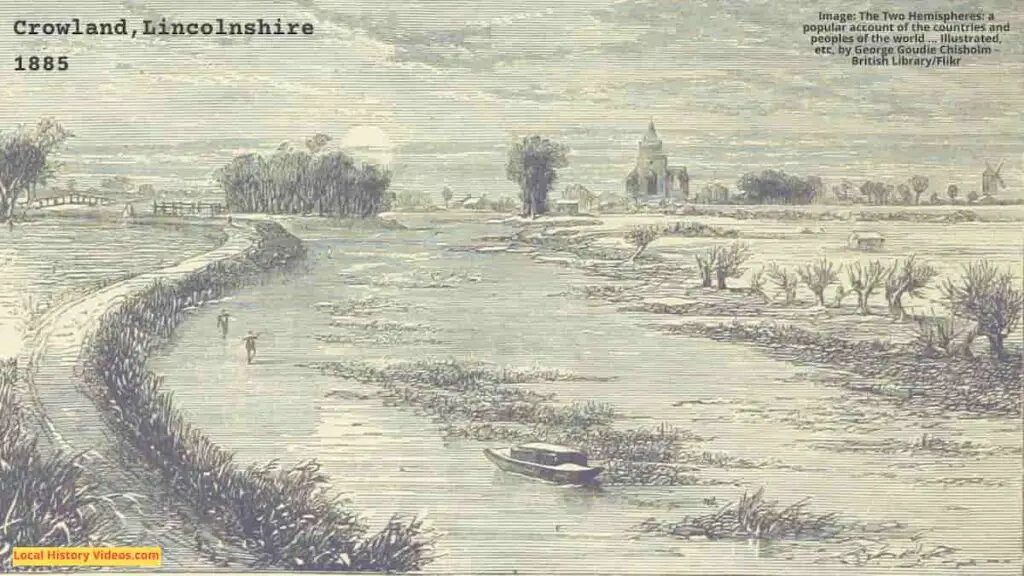Glimpse history through old images of Sleaford, Lincolnshire, England, UK.
Testing a Caravan 1954
In this curious footage from 1954, two men use waste ground near Sleaford to test the durability of a caravan designed for export to a Lebanese millionaire.
The fridge and air conditioning would have been revolutionary for the time, but it is still funny to think of this little caravan being bought by the very wealthy.
Caravan Tests (1954) – British Pathé (YouTube)
A bit of Sleaford history
Extract from
Sleaford, and the wapentakes of Flaxwell and Aswardhurn
by Edward Trollope (bp. of Nottingham.)
Published in 1872
Pages 169 – 179
THE MARKET PLACE.
This consists of a large open space in the heart of the town, adjoining two of its principal streets, and enables the public to have an excellent view of the picturesque west front of the fine old Parish Church, the Sessions House, the Corn Exchange, and some of the principal shops of the town.
Formerly a Market Cross stood here nearly opposite to the north west door of the church. It consisted, as usual, of several steps, a base, on the sides of which were carved shields, each bearing a saltire between 4 roundels with the date 1575, and a shaft springing from it.
This cross was removed about 70 years ago, when for a time the base was preserved in the church, but has now disappeared.
Near to it strangely stood the Stocks and Whipping Post.
In a corresponding position on the other side of the gravelled way now crossing the Market Place long remained a less religious object, viz: a stout post buried in the ground, having its head covered with an iron plate and a ring inserted in it. This was a Bull Ring, to which unhappy bulls were attached and baited by dogs for the amusement of the people.
A few persons are still living at Sleaford who remember a bull being thus baited in the Market Place for the last time, about the year 1807, when at least one wretched dog was gored to death.
This post was at length taken up when Royalty had long ceased to countenance such a barbarous sport, and the riotous conduct that usually attended it, as well as a growing feeling against all such brutal scenes tending to degrade the tastes and habits of the populace, led to its total disuse throughout England.
A curious illustration of this once popular sport is supplied by the still existing sign of the Black Bull, in Southgate, of which an accurate cut is given. This is carved in stone, and represents a bull in the act of being baited. Tied by a cord round its neck to a low post or stake, one dog, after the manner of its kind, hangs upon the poor brute’s lip, while two
others are attacking it, and a man in the dress of the 17th century is urging them on. The 1whole is painted with appropriate colours. Above are the initials R. M. B., doubtless those of the then landlord of the Black Bull when the accompanying date of 1689 was cut, and below is a subsequent date with the initials I. W.
A Market is held at Sleaford every Monday, and five Fairs take place annually, viz: on Plough Monday, Easter Monday, Whit Monday, the 1st of October, and the 20th of October; the last of which is the most important, and represents the day on which the old feast of the Patron Saint of Sleaford, St. Dennis, was kept, or the 9th of October, according to the old style.
From the Market Place diverge the four principal streets of the town, severally called Northgate, Southgate, Eastgate and Westgate, not because there were ever gates and walls protecting the town, but simply because these streets led towards the four cardinal points, the common Lincolnshire expression, ” I am going this a gate ” illustrating the use of such terms, i.e., ” I am going this way. “
THE SESSIONS HOUSE.
This is a large and conspicuous stone building of the Tudor style, on the north side of the Market Place. It was built in 1829-30 at a cost of £ 7000, after the designs of Mr. Edward Kendall, by the late Mr. Charles Kirk. It contains a spacious Court, in which the Quarter and Petty Sessions are held, retiring rooms for the Magistrates and Grand Jury, and other apartments. In front of it is an arcade for the convenience of persons in attendance.
Formerly the only receptacle for prisoners or drunkards in Sleaford was a little building still standing on the eastern edge of the church yard, and only fit for a toolhouse.
This has now long since been disused as a place of detention, and in 1845 a Police Station with cells adjoining was built in a little street branching from Eastgate, at a cost of £ 1000, which, with some subsequent alterations and additions, serves its purpose well.
THE CORN EXCHANGE.
In 1857, the great desideratum of a Corn Exchange was supplied, after some difference of opinion as to the best site for the purpose had been brought to a happy conclusion. This stands next to the Bristol Arms, in the Market Place, and its Gothic elevation is not only handsome in itself, but one that harmonizes well with the buildings near it.
It was built by shareholders on a site sold to them for the purpose by the late Miss Bankes; its interior is spacious, handsome, and well adapted to its purpose. The roof is on the ridge and furrow system, glazed on one side, and boarded on the other, so as to supply ample but not too great an amount of light to the corn buyers and sellers, for whose use it was intended.
Underneath is a butter market, and attached to it are other rooms and offices.
The architects were Messrs. K Kirk and Parry, of Sleaford.
THE GRAMMAR SCHOOL.
This was founded in 1604, by Robert Carre, of Aswarby, second son of Robert Carre, the purchaser of so many estates near Sleaford, who also exhibited a charitable disposition by acts of benevolence towards the parishes of Rauceby and Sleaford.
He was High Sheriff of the county in 1581, and took part in quelling the rebellion against Elizabeth, fostered by the Earls of Northumberland and Westmoreland. He married, 1, the widow of Lord Gray, of Wilton, Lord Warden of the English Marshes; and 2, Cassandra, daughter of William Apreece, of Washingley, in the parish of Lutton, Hunts, and widow of Adlard Welby, of Gedney, but had no issue by either, and died two years later 1606.
The school was to be called The Free Grammar School of Sleaford, and was intended for the better education of the youth and children born or living with their parents within the parishes of New Sleaford, Old Sleaford, Aswarby, Holdingham, Quarrington, North Rauceby, South Rauceby, Anwick, Kirkby Laythorpe, and Evedon.
The Master was to receive £ 20 a year out of a freehold estate consisting of 100 acres of land in Gedney, probably acquired through Robert Carre’s marriage with the widow of Adlard Welby, and the rest of its profits was to be disposed of in alms to the poor of Old and New Sleaford and Holdingham at the discretion of the Trustees, in whom this estate was vested.
All went well with the school until Cromwell’s time, when, according to a memorandum in its records ” From 1644 until May 1646 the times were so confused in respect of warrs, that neither rents could be received, nor accounts taken up, yet the money that could be got was disposed of as appears by bills, & c., ” i.e. was alienated from its proper application.
After this the Masters again received their stipend, but at last this became so utterly insufficient that difficulty was found in securing the services of an efficient Master in Orders, and at one time the office was vacant for two years.
To improve its condition, a small house and garden at the extremity of Northgate was bought for the use of the Master in 1825, and in 1834 the present Master’s house and school – room adjoining were built.
The school was then started again under an order of Chancery, made April 7th, 1830, and certain regulations were agreed to by the Patron and Trustees for its future management in 1835.
It is under the control of the Marquis of Bristol as the present representative of the Founder, and ten Trustees resident in Sleaford.
The following is a list of the Masters:
A.D. 1640. – Anthony Baston
1608.-Mr. Browne
1609. Mr. Newell
1615. Mr. Etherington
1619. Rev. John Kitchen
1622. Mr. Northern
1629. Mr. Trevillian
1635. Rev. M. Fancourt
1638. Rev. Edmund Trevillian
1650. – Rev. Thomas Gibson
1663. – Rev. Peter Stevens
1683. – Rev. William North
1691. – Rev. Matthew Smith
1723. Rev. Benjamin Wray
1736. Rev. William Gunnil
1781. Rev. Edward Waterson
1811. Rev. Elias Huelin
1835. Rev. Henry Manton
1867. Rev. C. Child
ALVEY’S SCHOOL
William Alvey, by his will, dated 26th August, 1726, bequeathed an estate in Fishtoft to Trustees for the purpose of paying £ 20 annually for the education of poor children of New Sleaford, who were to be taught to read, write, sew, and knit.
He also left £ 8 annually to educate poor children at Balderton, and 408. a year to the Incumbents of Sleaford and Balderton to preach anniversary sermons.
The residue of the income from the estate was to be divided for the benefit of Sleaford and Balderton, in the proportion of two thirds to the former and one third to the latter. The gross annual income is now £ 160 a year.
New school – rooms and a house for the Master were erected in the Elizabethan style in connexion with this charity in 1851, at a cost of £ 1000 raised by subscription. These stand on a site in East – gate, given by the late Marquis of Bristol, and each school room can accommodate 100 children.
Several other persons left small sums in trust for the benefit of the scholars of this school; viz: Mrs. Ann Ashby, who bequeathed the interest of £ 20 for providing them with bibles and spelling books, in 1770, and Sir John Thorold, Bart., who the same year left the interest of £ 5 for the same purpose.
In 1785 James Harryman became their benefactor in a different way, by leaving the interest of £ 100 a year to provide shoes and stockings for them.
THE INFANT SCHOOL.
In 1855 a building in Westgate, formerly used as a theatre, was purchased by subscription and converted into a school – room for young children.
This is supported by subscription and a Government Grant, much to the benefit of the poorer classes of Sleaford.
WESLEYAN SCHOOLS.
These schools, adjoining the Wesleyan chapel, were erected by Mr. M. Bennison, after designs furnished by Messrs. Pattinson, of Ruskington, at a cost of £ 1100, and are intended to accommodate 200 children.
They are built of white brick, and consist of one large school – room, 48 feet long by 30 feet wide and 17 feet high, and class – rooms, well adapted for educational purposes.
CARRE HOSPITAL.
This was founded by Sir Robert Carre, 3rd Baronet, son of Sir Edward Carre, Bart., and nephew of Robert Carre the founder of the Grammar School, on his coming of age in 1636.
It was intended for the use and support of twelve poor men, three to be chosen from New Sleaford and Holdingham, two from Kirkby Laythorpe, one from Quarrington and Old Sleaford, two from Great or North Rauceby, with power to select from Little or South Rauceby if the former should not supply fitting persons, and one from Anwick, Asgarby, Little Hale and Aswarby.
He endowed it with the great tithes of Metheringham and Kirkby Laythorpe, a rent charge of £ 20 out of the manor of Kirkby, and the site of the Hospital in Sleaford.
This last is situated south of the church, on which the ancient residence of the Carre family stood – called Carre House, and described by Leland as being one of the great ornaments of the town.
A portion of this seems to have constituted the Hospital until 1823, judging from a slight sketch of its appearance, when it was pulled down and the materials were used in building a chapel in the autumn of that year.
Then also the road to the Navigation was altered, which previously ran through the Hospital ground.
In 1844 this chapel was taken down and replaced by the present one, when the Hospital itself also was almost entirely rebuilt as it exists at present, forming two sides of a quadrangle with the chapel in the middle of the facade facing the fine old Parish Church.
The following year, through the enlargement of the building, six additional poor men were provided for in accordance with a new scheme then sanctioned by the Court of Chancery.
At the in closure of Metheringham parish in 1777, an allotment was made to the Hospital in lieu of the glebe and tithes of 777 acres of land, and in 1852 the great tithes of Kirkby Laythorpe were commuted for an annual payment to the Hospital of £ 130 charged upon the estates of the Marquis of Bristol.
In 1857, when the funds of the Hospital had accumulated to a considerable extent, an addition to the number of inmates was determined on by the Governors, and as there was not room for this on the old site a new one in Northgate adjoining the Grammar School was purchased, and a handsome building in the Tudor stylo erected, sufficient for the accommodation of eight extra pensioners, who now enjoy in common with their brethren of the older building the great boon bequeathed to them by Sir Robert Carre.
Each of these is allowed 10s. a week in addition to their comfortable apartments, a blue cloth cloak and some coals; besides the services of a chaplain, a medical attendant, and a nurse.
The Hospital is managed by five Lay and four Clerical Governors. The former at this time are Sir T. Whichcote, Bart., H. Chaplin, Esq., M.P., Charles Pearson, Esq., H. Peake, Esq.,
W. H. Holdich, Esq.; the latter, the Vicar of Sleaford, the Rector of Aswarby, the Rector of Kirkby Laythorpe cum Asgarby, the Rector of Quarrington, and the Vicar of Anwick cum
Brauncewell.
Their annual meeting is on Whit Tuesday, when they and the Bedesmen have a dinner, vacancies are filled up, and the business of the trust is transacted.
THE UNION HOUSE.
This stands on the north side of the Sleaford and Tattershall Road, and is a much more pleasing building than the prison – like type usually adopted.
It is of the Tudor style, and built of Ancaster stone after the designs of the late Mr. W. J. Donthorn, of London, in 1838, at a cost of £ 4000; but since then much has been done to render it more commodious.
It is intended for the use of the Wapentakes of Aswardhurn, Flaxwell, Langoe, Loveden, Aveland and Boothby Graffoe, which comprise 56 parishes or townships, and is a very well managed Institution.
THE VICARAGE.
This is on the north side of the church, and abuts immediately upon the churchyard.
The original parsonage stood at the east end of the church, as we learn from Leland, and was one of the only two very good houses he remarked on his visit to Sleaford, his words being ” For houses in the towne I marked but 2 very faire, the one longith to the personage as a prebend of £ 16 yn Lincoln, and standith at the est ende of the chirch. ”
This stood eastward of the present Waggon and Horses, and its representative, together with the old tithe yard, were sold in 1797 to redeem the land tax.
It was taken down in 1816 and replaced by a small new house.
The present vicarage house was most probably the residence of one of the chantry priests attached to the church of Sleaford, and part of it is of the latter end of the 16th century, bearing the date 1568 on its gable facing the church. It has of late been added to and improved.
OLD HOUSES.
There are several houses still remaining in Sleaford of that style of domestic architecture prevalent in England from the reign of Elizabeth to that of Charles II.
A portion of one of these now forms an adjunct of Miss Peacock’s house in North gate. All its details are not honestly its own, but it is a picturesque fragment that generally attracts attention; and on a building in the stable yard adjoining is a very beautiful medieval chimney shaft, brought from the old Deanery, at Lincoln.
Opposite to this is an exceedingly well – designed modern public house, called the Marquis of Granby, in which a little old bay window is inserted, brought from an ancient house that formerly stood on the site of the present Corn Exchange; and a little southward of it is another small ancient house, having a gable filled with characteristic mullioned windows.
On the east side of Eastgate, just beyond the chancel of the parish church, is a larger house of the same date. This adjoins the site of the old residence of the Carres, and perhaps was built by one of that family, although nothing is now known of its history previous to 1707, when it was bought by Mr. Austen Cawdron, whose family was connected with that of the Carres by marriage. Four years later it was sold to Mr. John Peart, of Sleaford, and in 1773 to Mr. John Brown, Mayor of Lincoln, at which time it was occupied by Sir William Moor, Bart. The next year it was sold to the Rev. John Andrews, and at his death in 1800, was sold to the grandfather of the present owner, Mr. Henry Snow.
It is a picturesque gabled house, and still retains its original chimneys, one or two of its mullioned windows, and the head of a handsome doorway opening into the garden attached to it, but not now standing in its original position.
Of a later period is the handsome old house adjoining the Sessions House, now constituting the bank of Messrs. Peacock and Handley.
CHARITABLE BEQUESTS.
At a date unknown, but probably at the beginning of the 17th century, John Cammocke left a house and garden in Southgate with some land in the open field beyond, the rents of which were to be applied to the embellishment of the parish church.
This bequest is now represented by three tenements, a yard and garden in Southgate, and 3 acres 2 roods and 13 perches, let at £20 a year, situated on the north side of the Tattershall road.
In 1631, Robert Cammoeke the younger charged a farm at Harmston, now in the possession of B. H. Thorold, Esq., with an annual payment of £ 14; of which £ 5 were to be given to the Vicar of Sleaford, £ 4 to the Master of the Carre Grammar School, and £ 4 were to be devoted to the purchase of a freize gown, a pair of shoes, and a pair of stockings for five poor persons, if the fund allowed of this.
In 1657, Henry Callow left two fields in Ruskington, out of the rents of which £ 2 were to be paid annually to the Vicar of Sleaford, and £ 5 for the purchase of five gowns, five pairs of shoes, and five pairs of stockings to be given to five poor persons of New Sleaford; after which the surplus was to be expended in the reparation of the church at the discretion of the church wardens.
In 1681, Samuel Raulinson left a yearly rent of £ 5 derived from his house, called the Old Hall, in Sleaford, now a blacksmith’s shop, to the poor of the parish.
In 1688, Miles Long gave 20s. a year to the Vicar of Sleaford, secured on two houses in Southgate, now belonging to Mr. Hipkin and Mrs. Green. In 1715, James Harryman left the interest of £ 150, to be expended in bread for the poor.
In 1730, Margaret Kinsey and others left a small sum to be expended annually in bread for the poor, to be distributed on St. Thomas’s day. This is secured on the Old Hall, now belonging to Mr. Hackett.
In 1784, Susannah Darwin, of Sleaford, left £100 in trust, the interest of which was to be given to the organist of the parish church.
In 1788, Ann Fenwick, of Sleaford, left £50, the interest of which was also to be given to the organist of Sleaford.
In 1835, Mrs. Anne Bankes left £400, the interest of which was to be spent in the purchase of coals and flour to be given to twelve poor women of Sleaford, and the same number of Gosberton.
In 1841, Benjamin Holmes left £100, the interest of which was to be distributed in money among the poor widows of New Sleaford, on the 15th of August every year, and was to be called Holmes’s gift.
THE RAILWAY FROM SLEAFORD TO GRANTHAM AND BOSTON.
For this great boon Sleaford is indebted to the late Mr. Herbert Ingram, M.P., for Boston, by which it is placed in easy reach not only of Boston and Grantham, but of Nottingham, Lincoln and London.
That portion of it between Grantham and Sleaford was finished and opened formally, June 13th, 1857.
It is 14 miles in extent, and was made at the cost of about £ 8000 a mile, by Messrs. Smith and Knight.
Its completion was celebrated by a grand dinner given by the Directors, in the Goods Shed of the Sleaford Station, and a general holiday in the town, when all sorts of good wishes were uttered in behalf of the new line, which have been amply fulfilled.
Subsequently the line was extended from Sleaford to Boston, when great rejoicings took place at Boston, and a first excursion trip was made by the Directors and their friends from Boston to Grantham; after which, as at Sleaford, the day concluded with a public dinner in the Exchange Hall, under the presidency, as before, of the late Mr. Herbert Ingram, whose life has since been so lamentably lost through a calamitous accident in America.

